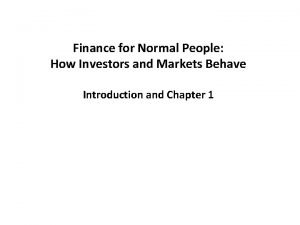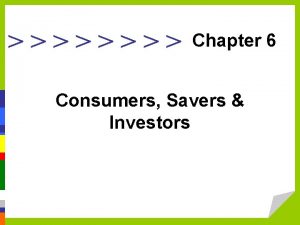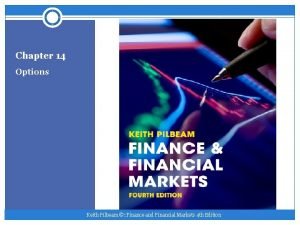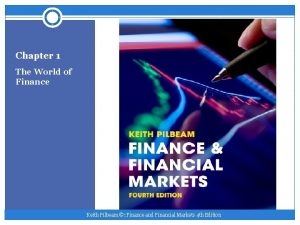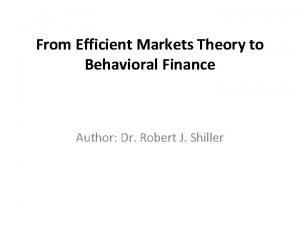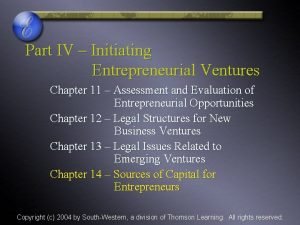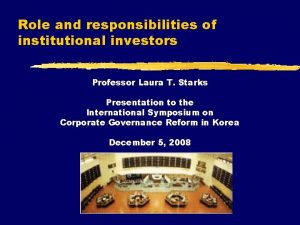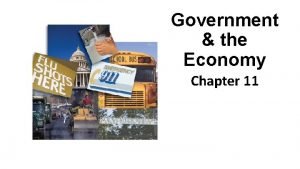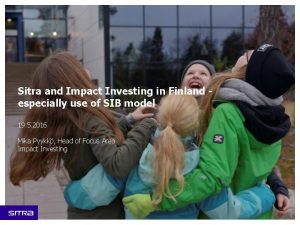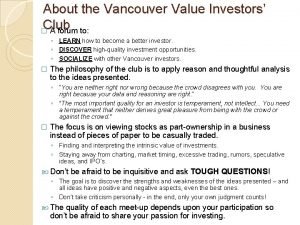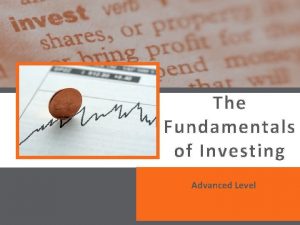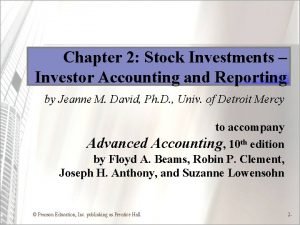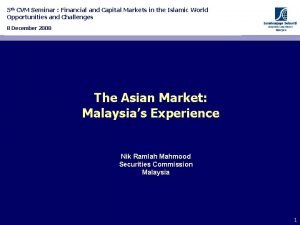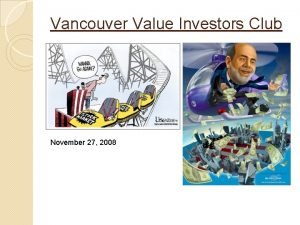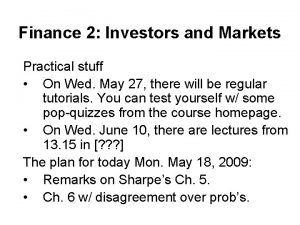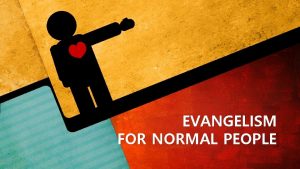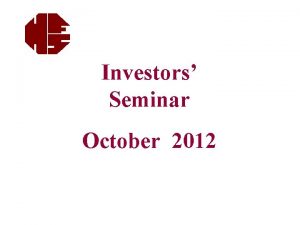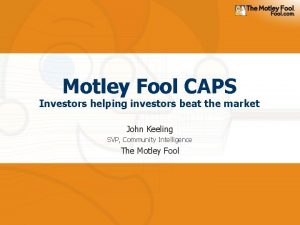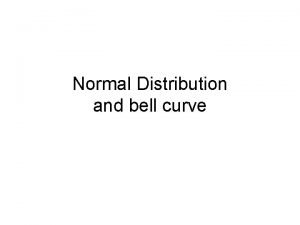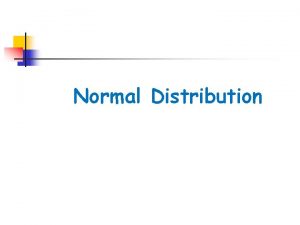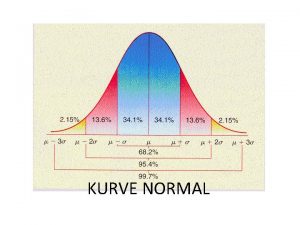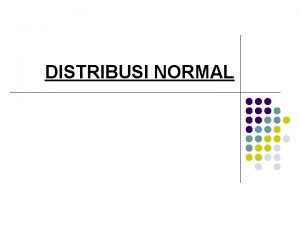Finance for Normal People How Investors and Markets




















- Slides: 20

Finance for Normal People: How Investors and Markets Behave Introduction and Chapter 1

Finance For Normal People: How Investors and Markets Behave Introduction: What is Behavioral Finance? Part 1: Behavioral People are Normal People Chapter 1: Normal people Chapter 2: Our wants for utilitarian, expressive, and emotional benefits Chapter 3: Cognitive shortcuts and errors Chapter 4: Emotional shortcuts and errors Chapter 5: Correcting cognitive and emotional errors

Finance For Normal People: How Investors and Markets Behave Chapter 6: Experienced happiness, life-evaluation, and choices: Expected Utility Theory and Prospect Theory Chapter 7: Behavioral Finance Puzzles: The dividend puzzle, the disposition puzzle, and the puzzles of dollar-costaveraging and time-diversification

Finance For Normal People: How Investors and Markets Behave Part 2: Behavioral Finance in Portfolios, Life-Cycles, Asset Prices, and Market Efficiency Chapter 8: Behavioral portfolios Chapter 9: Behavioral life-cycle of saving and spending Chapter 10: Behavioral asset pricing Chapter 11: Behavioral market efficiency Chapter 12: Lessons of behavioral finance

Foundation blocks of standard and behavioral finance Standard finance Behavioral finance 1. People are rational 1. People are normal

Foundation blocks of standard and behavioral finance Standard finance Behavioral finance 2. People construct portfolios as described by meanvariance portfolio theory, where people’s portfolio wants include only high expected returns and low risk 2. People construct portfolios as described by behavioral portfolio theory, where people’s portfolio wants extend beyond high expected returns and low risk, such as for social responsibility and social status

Foundation blocks of standard and behavioral finance Standard finance Behavioral finance 3. People save and spend as described by standard lifecycle theory, where people find it easy to find and follow the right way to save and spend 3. People save and spend as described by behavioral lifecycle theory, where impediments, such as weak self-control, make it difficult to find and follow the right way to save and spend

Foundation blocks of standard and behavioral finance Standard finance Behavioral finance 4. Expected returns of investments are accounted for by standard asset pricing theory, where differences in expected returns are determined only by differences in risk 4. Expected returns of investments are accounted for by behavioral asset pricing theory, where differences in expected returns are determined by more than differences in risk, such as by levels of social responsibility and social status

Foundation blocks of standard and behavioral finance Standard finance Behavioral finance 5. Markets are efficient, in the sense that prices equal values in them and in the sense that they are hard to beat 5. Markets are not efficient in the sense that prices equal values in them, but they are efficient in the sense that they hard to beat

Why do we behave as we do? Rational, Irrational, and Normal Behavior 1 st generation behavioral finance 2 nd generation behavioral finance Because we are irrational Because we are normal, pursuing what normal people want We fall victim to cognitive and emotional errors on our emotional errors way to what we want

Why do we behave as we do? Rational, Irrational, and Normal Behavior Standard Finance says: Rational people do not buy lottery tickets

Why do we behave as we do? Rational, Irrational, and Normal Behavior 1 st generation Behavioral Finance says: Irrational people buy lottery tickets because they are fooled by cognitive errors – exaggerating the odds of winning

Why do we behave as we do? Rational, Irrational, and Normal Behavior 2 nd generation Behavioral Finance says: Normal people buy lottery tickets for the emotional benefits of hope of winning and the utilitarian benefits of the miniscule odds of winning

Rational and Normal Standard finance – People are rational Merton Miller and Franco Modigliani in their 1961 article on dividends: a. Rational people always prefer more wealth to less b. Rational people are never confused by the form of wealth Rational people are indifferent between company-paid dividends and “homemade” dividends created by selling shares Normal people are not indifferent between company-paid dividends and “homemade” dividends

Rational and Normal Behavioral finance - People are normal Normal people have normal wants, such as social responsibility, social status, and caring for family Normal people use cognitive and emotional shortcuts on the way to their want At times, cognitive and emotional shortcuts become cognitive and emotional errors Framing errors are one example: Normal people are often confused by the form of wealth

Rational and Normal Company-paid dividends versus “homemade” dividends (in the absence of transaction costs or taxes) $50, 000 Capital $48, 500 Capital $1, 500 Dividend

Cognitive and Emotional Shortcuts and Errors Which restaurant should we choose for dinner tonight? Good shortcuts take us close to the best choices, solutions, and answers Cognitive and emotional shortcuts turn into errors when they take us far from our best choices

System 1 and System 2 Intuition, reflected in cognitive and emotional shortcuts, leads us right in most of life. But reflection leads us better when intuition misleads System 1 is the intuitive “blink” system in our minds - automatic, fast, and effortless System 2 is the reflective “think” system in our minds - controlled, slow, and effortful

Three kinds of knowledge 1. Financial-facts knowledge - Facts about finance and financial markets 2. human-behavior knowledge - Knowledge is about our wants, the cognitive and emotional shortcuts we take, and the errors we make 3. Information knowledge – Exclusively-available, narrowly available, and widely-available information

Transformation from ignorant to knowledgeable Teachers guide in the search and application of financial-facts, humanbehavior, and information knowledge Experience can also be a good teacher We pay in money, time, and exertion, both physical and mental, when we transform ourselves from ignorant into knowledgeable We pay in money, time, and exertion when we substitute the reflective System 2 for the intuitive System 1 Transformation is worthwhile when benefits exceed costs
 Finance for normal people: how investors and markets behave
Finance for normal people: how investors and markets behave Savers and investors role in financial markets
Savers and investors role in financial markets Savers and investors role in financial markets
Savers and investors role in financial markets Pilbeam k. finance and financial markets
Pilbeam k. finance and financial markets Finance and financial markets keith pilbeam
Finance and financial markets keith pilbeam From efficient markets theory to behavioral finance
From efficient markets theory to behavioral finance Pros and cons of angel investors
Pros and cons of angel investors Roles and importance of institutional investors
Roles and importance of institutional investors Protecting consumers savers and investors examples
Protecting consumers savers and investors examples Sibwork
Sibwork Monash investors
Monash investors Rupertlawgroup.com e2-visa-requirements-investors
Rupertlawgroup.com e2-visa-requirements-investors Value investors club india
Value investors club india Good morning investors
Good morning investors Investors in accounting
Investors in accounting The railroad had primary investors who were known as
The railroad had primary investors who were known as Chapter iv investors
Chapter iv investors Cvm investors hub
Cvm investors hub Valueinvestorsclub
Valueinvestorsclub People medi
People medi Black eyed peas
Black eyed peas
